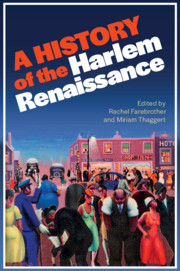Book contents
- A History of the Harlem Renaissance
- A History of the Harlem Renaissance
- Copyright page
- Dedication
- Contents
- Illustrations
- Contributors
- Acknowledgments
- Introduction: Revising a Renaissance
- Part I Re-reading the New Negro
- Part II Experimenting with the New Negro
- Part III Re-mapping the New Negro
- Part IV Performing the New Negro
- Chapter 15 Zora Neale Hurston’s Early Plays
- Chapter 16 Zora Neale Hurston, Film, and Ethnography
- Chapter 17 The Pulse of Harlem: African American Music and the New Negro Revival
- Chapter 18 The Figure of the Child Dancer in Harlem Renaissance Literature and Visual Culture
- Chapter 19 Jazz and the Harlem Renaissance
- Chapter 20 Alain Locke and the Value of the Harlem Renaissance
- Afterword
- Bibliography
- Index
Chapter 19 - Jazz and the Harlem Renaissance
from Part IV - Performing the New Negro
Published online by Cambridge University Press: 20 January 2021
- A History of the Harlem Renaissance
- A History of the Harlem Renaissance
- Copyright page
- Dedication
- Contents
- Illustrations
- Contributors
- Acknowledgments
- Introduction: Revising a Renaissance
- Part I Re-reading the New Negro
- Part II Experimenting with the New Negro
- Part III Re-mapping the New Negro
- Part IV Performing the New Negro
- Chapter 15 Zora Neale Hurston’s Early Plays
- Chapter 16 Zora Neale Hurston, Film, and Ethnography
- Chapter 17 The Pulse of Harlem: African American Music and the New Negro Revival
- Chapter 18 The Figure of the Child Dancer in Harlem Renaissance Literature and Visual Culture
- Chapter 19 Jazz and the Harlem Renaissance
- Chapter 20 Alain Locke and the Value of the Harlem Renaissance
- Afterword
- Bibliography
- Index
Summary
This chapter studies the literary representation of dancers, particularly child dancers, in Harlem Renaissance fiction, arguing that this focus can help explore anxieties about generational conflict, gender, sexuality, tradition, and urban life. Attending to representations of children provides a fresh perspective from which to examine the significance of dance both in relation to questions of cultural identity (including black modernists’ engagement with the legacies of minstrelsy) and the emotional cultural politics of the Harlem Renaissance. Against the backdrop of a broader preoccupation with black childhood among social scientists, educators, and political activists, representations of child dancers were freighted with contradictory emotions that complicated discourses of racial uplift. This chapter engages with a range of texts, including Zora Neale Hurston’s “Drenched in Light” and Dorothy West’s “An Unimportant man,” to argue that dancing children sometimes embody new possibilities for the future and resistant aesthetics that defy categorization, but they make for anxious, loaded imagery that flickers between embarrassment and pride, pleasure and unease.
Keywords
- Type
- Chapter
- Information
- A History of the Harlem Renaissance , pp. 345 - 360Publisher: Cambridge University PressPrint publication year: 2021
- 1
- Cited by

